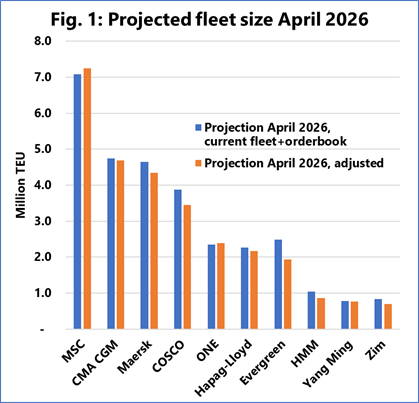With Mediterranean Shipping Company (MSC) having upended the status quo and overtaken Maersk in terms of fleet size, there’s more to come, according to forecasts by Sea-Intelligence.
Its fleet size forecast sees CMA CGM overtaking Maersk to take second spot, followed by Maersk and Cosco by April 2026.
Sea-Intelligence CEO Alan Murphy explains that when forecasting the future fleet sizes of shipping lines, it is quite common to add the current fleet size to the size of the order book. While convenient, he says, this approach is rather one-dimensional, as shipping lines can also trade in the second-hand market, and increase or decrease their use of chartered vessels.
“A more comprehensive method is to look at the fleet adjustment strategy of individual shipping lines in recent years and use this perspective to project their anticipated fleet size into the future,” adds Murphy.
“This is under the assumption that each carrier maintains the same approach to their second-hand tonnage strategy, as well as their own vs charter strategy.
“If we were to use the more simplistic approach to predict the current fleet sizes, based on the actual fleet and order book from two years ago, for eight of the 10 largest carriers, the actualised fleet growth turns out to be less than what the simplistic projection would suggest. This implies that the delivery of newbuilds typically leads most carriers to also shed capacity, by selling owned tonnage in the second-hand market or redelivering charter tonnage. Only MSC and ONE deviate from this, by also taking in additional tonnage.”

Figure 1 shows the projected fleet sizes in April 2026, if a simplistic or adjusted approach is taken (ie, also accounts for current tonnage strategies), which assumes that the strategic approach followed in the last two years will also apply in the coming two years. “With this, we can see that MSC will grow their size advantage substantially compared to CMA CGM – which will become the second-largest carrier, relegating Maersk to third.”
Also noteworthy, says Murphy, is that Hapag-Lloyd has recently issued its new 2030 strategy and one of the priorities is that it remains a top-five carrier. “This will require a change in approach compared to the last two years, as otherwise they will be pushed to a ranking of sixth, behind ONE.”













